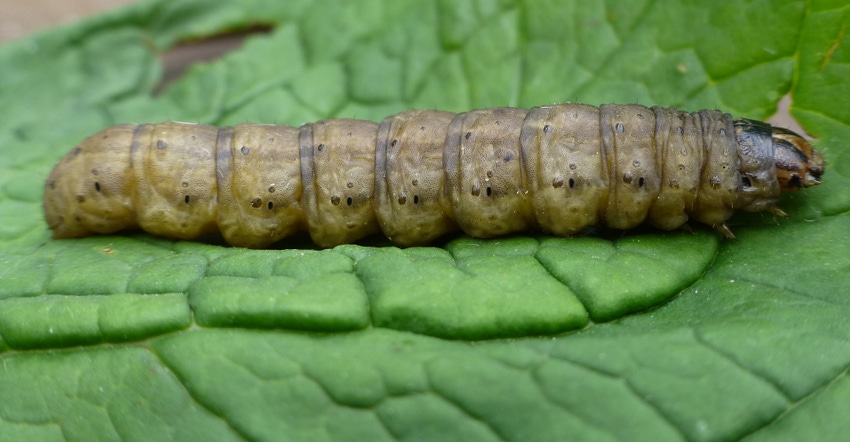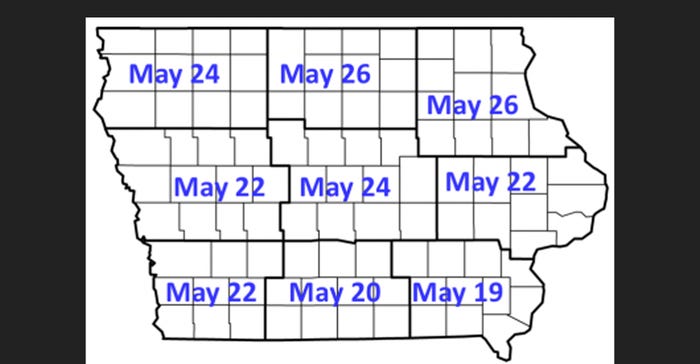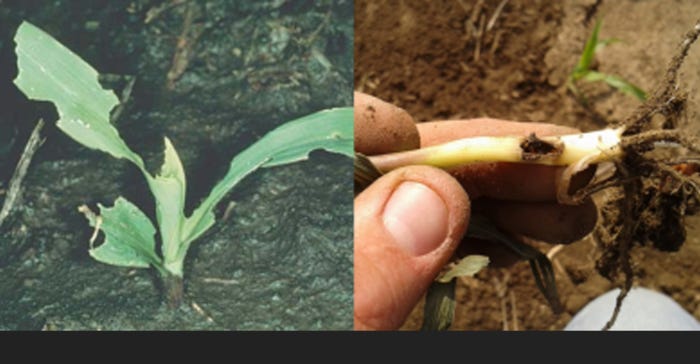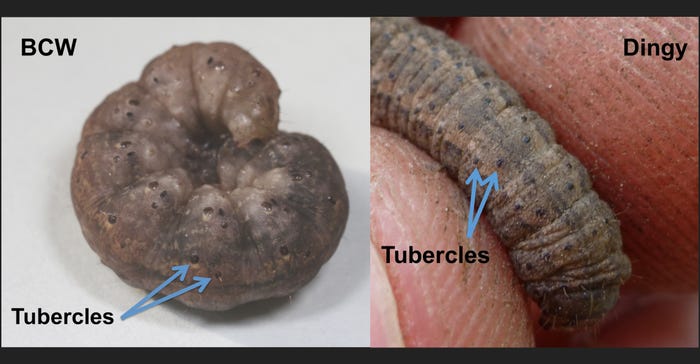
When corn emerges and the seedlings begin to grow, it’s time to start scouting for black cutworms and other early-season insect pests, such as armyworms.
Black cutworm is a migratory pest that feeds on early vegetative-stage corn plants. Black cutworm moths arrive in Iowa and other Northern states with spring storms each year. These moths lay eggs in and around crop fields, the eggs hatch, and emerging black cutworm larvae (worm stage) can cut off the seedling corn plants.
This pest is sporadic, making it essential to scout fields to determine if management is needed. Scouting cornfields for the presence of cutworm larvae helps to determine if an insecticide application will be cost-effective. Iowa State University Extension entomologist Erin Hodgson and ISU integrated pest management specialist Adam Sisson provide the following information.
When to scout fields for cutworm
When to start scouting for black cutworm caterpillars is based on the “peak flight” of moths and accumulating degree days after the peak flight. Degree days are a measure of temperature used to gauge insect development. A peak flight for black cutworm moths is defined as capturing eight or more moths over two nights in a wing-style trap baited with a pheromone lure.
To find out when moths arrive in Iowa, volunteer cooperators around the state monitor these pheromone traps and report moth captures. This spring, they started checking traps at the beginning of April, and captures of black cutworm moths did not occur until mid-April. Moth captures picked up during the last part of April and early May, with several peak flights recorded. The peak flights observed during this period were in line with captures in surrounding states.
Predicted dates for cutting to begin
The map accompanying this article shows predicted black cutworm cutting dates for the nine Iowa crop reporting districts, based on actual and historical degree day data and peak flights during late April and early May. These dates are when you may see cutworms begin to cut off corn plants in fields.
“We may continue to see peak flights occur in Iowa,” says Hodgson. “Adult moth trap captures do not necessarily mean there will be economically significant black cutworm infestations in a particular location. Field scouting is essential to determine if an economically damaging infestation exists. Also, as you are out in fields assessing stands, be on the lookout now for early-season insect injury in corn, black cutworm or otherwise.”

PREDICTED DATES: Above are the estimated dates for black cutworm cutting to begin in Iowa, based on peak flights of moths occurring in 2018.

Several states bordering Iowa also track black cutworm moth flights and make estimates about cutting dates, especially to the North and East. Several of the predictions in these states are close to the Iowa border, and some are for counties directly adjacent to Iowa. Data from these out-of-state locations may be informative for Iowans farming nearby. Extension resources on black cutworm can be found at the University of Minnesota, Wisconsin Pest Bulletin and University of Illinois The Bulletin.
Scouting tips
Poorly drained, low lying or weedy fields, as well as those next to natural vegetation or with reduced tillage, may have higher risk of cutworm injury, says Hodgson. Cornfields with poorly terminated cover crops may also be attractive to egg-laying females. Late-planted corn can be smaller and more vulnerable to larval feeding. Some Bt corn hybrids provide suppression of black cutworm (hybrids containing the Vip3A, Cry1A.105, Cry2Ab2 and Cry1F proteins), but even so, cutworm larvae can still cut off these young plants.
“We encourage scouts to start looking for any cutworm activity during early-season stand assessment, or at least several days before the estimated cutting dates,” says Hodgson. “Early scouting is important because local development of the larvae may be different due to weather variation within an area. Fields should be scouted for larvae weekly until corn reaches the V5 stage of growth.”
Hodgson says you should examine 50 corn plants in five areas in each field. Look for wilting, leaf discoloration and damage, or plants that are missing or cut. Flag areas with suspected feeding and return later to assess further injury. Larvae can sometimes be found by carefully digging in the soil around a damaged plant.

INJURY SIGNS: Black cutworm injury to corn usually begins above the soil surface. Look for leaf feeding. As larvae mature they can severely damage or kill plants.

Black cutworm larvae (left) have grainy, light grey to black skin and four pairs of fleshy prolegs on the end of the abdomen. There are pairs of dark tubercles, or bumps, along the side of the body. The pair of tubercles nearest the head is approximately a third to half the size of the pair closest to the abdomen (see below). Black cutworm larvae can be confused with other cutworms such as dingy cutworm (right) and armyworms.

IDENTIFY CORRECLTY: Black cutworm (left) is distinguished from other larvae, like dingy cutworm (right), by dark tubercles on the middle of the back. On each segment, the tubercle closest to the head is about a third the size of the tubercle closest to the rear for black cutworm. Dingy cutworm tubercles on each segment are roughly the same size.

When does it pay to apply an insecticide to rescue corn from cutworm? ISU’s Hodgson and Sisson point out that common thresholds for treating seedling corn plants and plants in the V2, V3 and V4 stage of growth are when two, three, five and seven plants are cut off out of 100 plants in the sample, respectively. However, they also point out that using a dynamic threshold for black cutworm treatment may be best with corn price and input fluctuations.
An Excel spreadsheet with calculations built in can be downloaded here and used to help with black cutworm management decisions.
While rescue treatments are recommended, applying an insecticide as a preventive treatment is not. Preventive black cutworm insecticide treatments applied as a tank-mix with herbicides are a questionable practice, says Hodgson. Black cutworm is a sporadic pest and every field should be scouted to determine insect presence before spraying insecticides.
“If you see any fields with black cutworm larvae while scouting, please let us know by sending a message to [email protected],” says Sisson. “This information you provide could help us to refine our future predictions.”
About the Author(s)
You May Also Like




